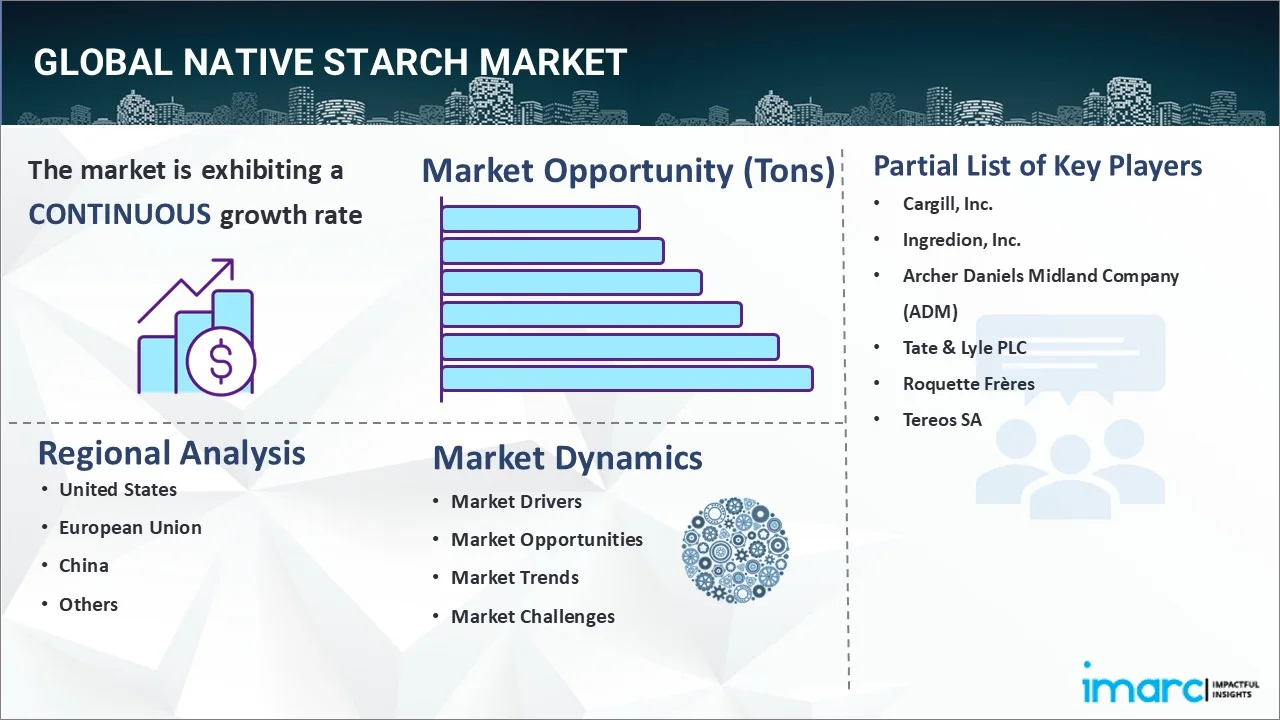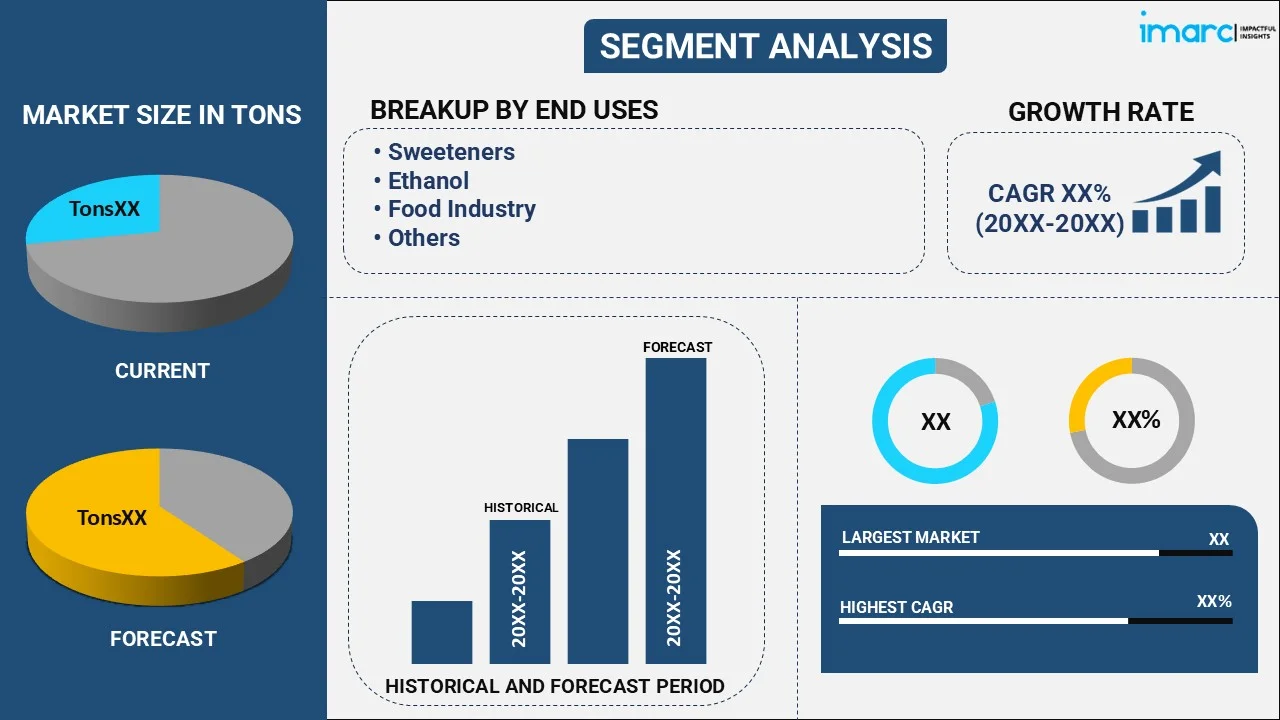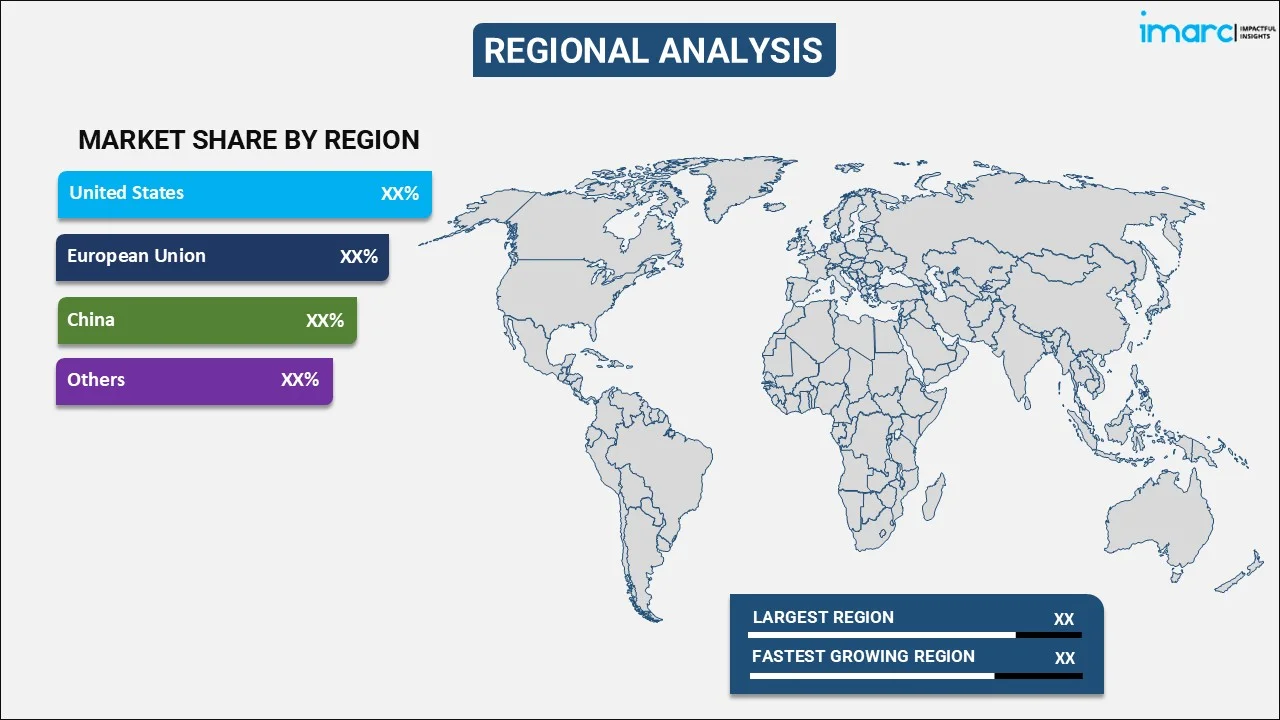
Native Starch Market Report by End Use (Sweeteners, Ethanol, Food Industry, Paper Industry, and Others), Feedstock (Corn, Wheat, Cassava), and Region 2025-2033
Market Overview:
The global native starch market size reached 97.7 Million Tons in 2024. Looking forward, IMARC Group expects the market to reach 112.4 Million Tons by 2033, exhibiting a growth rate (CAGR) of 1.52% during 2025-2033. The increasing demand for convenience foods, shifting consumer preference for natural ingredients, rising usage of native starch sweeteners, growing demand for gluten-free products, and expanding industrial applications are some of the major factors propelling the market.
|
Report Attribute
|
Key Statistics
|
|---|---|
|
Base Year
|
2024
|
|
Forecast Years
|
2025-2033
|
|
Historical Years
|
2019-2024
|
|
Market Size in 2024
|
97.7 Million Tons |
|
Market Forecast in 2033
|
112.4 Million Tons |
|
Market Growth Rate 2025-2033
|
1.52% |
Native starch is the pure, raw form of starch procured from various plant sources, such as corn, wheat, potatoes, or tapioca. It is extracted from these sources and retains its natural properties without any chemical or physical modifications. Native starch is commonly used in food and industrial applications due to its thickening, stabilizing, and gelling properties. In the food industry, it serves as a thickener in soups, sauces, and dressings. In the industrial sector, native starch finds use in the production of paper, textiles, and adhesives. Its natural composition and versatility make it a valuable ingredient in various manufacturing processes.

The global native starch market is primarily driven by the widespread product utilization as a thickening and stabilizing agent and the rising demand for convenience foods and processed products. Besides this, as consumers' lifestyles become busier, the demand for ready-to-eat (RTE) meals, sauces, and dressings has surged, boosting the utilization of native starch in the food industry. Additionally, the rising awareness among consumers regarding the benefits of natural and unmodified ingredients in food products has led to an increased preference for native starch over modified starches, strengthening the market growth. Moreover, the expanding industrial sectors, such as paper, textiles, and adhesives, rely heavily on native starch for its adhesive and binding properties, impelling its demand. Furthermore, the wide availability of raw materials, including corn, wheat, and potatoes, from which native starch can be extracted, is contributing to its market growth.
Native Starch Market Trends/Drivers:
Increasing demand for convenience and processed foods
The rising trend of urbanization and changing consumer lifestyles have led to a significant increase in the consumption of convenience foods and processed products worldwide. Consumers are seeking easy-to-prepare and RTE meals, as well as processed sauces, dressings, and soups, to fit their busy schedules. Native starch, being a natural and pure thickening and stabilizing agent, plays a crucial role in enhancing the texture, appearance, and overall quality of these food products. Its ability to provide improved mouthfeel, viscosity, and shelf stability has made it an essential ingredient in various food applications. As the demand for convenience and processed food products continues to rise, the requirement for native starch as a key functional ingredient is also growing, positively impacting the global market.
Shifting consumer preference for natural ingredients
In recent years, there has been a significant shift in consumer inclination toward healthier and more natural food options. Consumers are increasingly conscious of the ingredients present in the products they purchase and are seeking clean-label options with minimal chemical modifications. Native starch perfectly aligns with this demand as it is extracted directly from plant sources, such as corn, wheat, potatoes, or tapioca, without any chemical alterations. This natural composition makes it a preferred choice over modified starches, which may contain additives or undergo various chemical processes. As consumers become more health-conscious and demand transparency in food labeling, the demand for native starch as a natural and unmodified ingredient is witnessing substantial growth.
Expanding industrial applications
Beyond the food industry, native starch finds significant usage in various industrial sectors, such as paper manufacturing, textiles, and adhesives. In the paper industry, native starch is utilized as a binding agent to improve paper strength and enhance printability. In the textile industry, it acts as a sizing agent, providing stiffness and smoothness to fabrics. Native starch's adhesive properties make it an essential component in the production of adhesives for industries like packaging, woodworking, and construction. The continuous growth of these industries, particularly in developing regions, is driving the demand for native starch in the industrial sector. Moreover, its biodegradability and eco-friendliness further bolster its adoption as an environmentally sustainable choice in various applications.
Native Starch Industry Segmentation:
IMARC Group provides an analysis of the key trends in each segment of the global native starch market report, along with forecasts at the global and regional levels from 2025-2033. Our report has categorized the market based on end-use and feedstock.
Breakup by End Use:

- Sweeteners
- Ethanol
- Food Industry
- Paper Industry
- Others
Sweeteners hold the largest share in the market
A detailed breakup and analysis of the market based on the end use has also been provided in the report. This includes sweeteners, ethanol, food industry, paper industry, and others. According to the report, sweeteners accounted for the largest market share.
The global native starch market is experiencing significant growth, with sweeteners, particularly native starch sweeteners such as tapioca syrup and rice syrup, driving the largest market share. These natural sweeteners are gaining popularity as healthier alternatives to traditional sweeteners, offering a balanced glycemic profile and appealing to individuals with specific dietary needs.
Moreover, the growing consumer awareness of their health benefits has led to increased adoption in various food and beverage applications, creating a favorable market outlook. Besides this, the rising demand for gluten-free products is also contributing to the success of native starch sweeteners. As more people seek gluten-free options due to celiac disease, gluten intolerance, or dietary preferences, the demand for these sweeteners sourced from gluten-free plants has surged. This combination of health consciousness and gluten-free trends is influencing the dominance of sweeteners in the native starch market, propelling the market growth.
Breakup by Feedstock:
- Corn
- Wheat
- Cassava
Corn dominates the market
The report has provided a detailed breakup and analysis of the market based on the feedstock. This includes corn, wheat, and cassava. According to the report, corn represented the largest segment.
Corn has emerged as the leading contributor to the global native starch market due to its extensive utilization in diverse commercial sectors. The rising demand for native starch in various commercial institutions, such as hotels and restaurants, is driven by its multifunctional properties in food preparation and processing. Native starch serves as a thickening and stabilizing agent in soups, sauces, gravies, and desserts, enhancing the overall texture and consistency of dishes.
Additionally, the beverage industry extensively employs native corn starch in the production of beverages such as soft drinks and fruit juices, where it aids in improving viscosity and mouthfeel. Furthermore, the industrial sector, encompassing paper, textile, and adhesive industries, also relies heavily on corn-based native starch for its superior binding and adhesive properties. Corn's widespread availability, coupled with its versatility and cost-effectiveness, strengthens its position as the dominant source of native starch across various applications.
Breakup by Region:

- Production
- United States
- European Union
- China
- Others
- Consumption
- North America
- European Union
- Asia Pacific
- Latin America
- Middle East and Africa
North America exhibits a clear dominance, accounting for the largest native starch market share
The report has also provided a comprehensive analysis of all the major regional markets on the basis of production, which includes United States, European Union, China, and Others. It also provides the market breakup on the basis of consumption, covering North America, European Union, Asia Pacific, Latin America, and Middle East and Africa. According to the report, North America accounted for the largest market share.
At present, North America represents the leading consumer. The increasing consumer awareness and preference for clean labels and natural food products in North America are driving the demand for native starch as a natural and unmodified ingredient. As consumers become more health-conscious, they seek food products with transparent labeling and minimal chemical modifications, which has led to a surge in the usage of native starch in various food and beverage applications. Moreover, the growing trend of gluten-free diets in the region is positively influencing the market demand for native starch, especially from gluten-free sources such as tapioca and rice. Furthermore, with a significant portion of the population diagnosed with celiac disease or adopting gluten-free diets for health reasons, there is a rising need for gluten-free alternatives in food manufacturing, leading to an increased preference for native starch. Additionally, the expanding industrial applications of native starch in North America, particularly in the paper, textiles, and adhesive industries, are contributing to the rising demand in the region.
Asia Pacific is expected to witness lucrative growth over the forecast period, driven by increasing demand from diverse industries. As a key player in the global starch industry, India is projected to play a significant role in this growth. The country's enormous agricultural resources, specifically in the production of staple crops such as wheat, rice, and corn, deliver a robust platform for the native starch industry growth. India is the second-largest producer of rice and wheat in the world. In addition, India's flourishing food processing sector, paired with growing consumer awareness of healthier food alternatives, is expected to fuel demand for native starches as a natural and versatile ingredient in different food products.
Competitive Landscape:
The global native starch market is highly competitive and characterized by the existence of several established players and regional manufacturers. Key companies are continuously striving to strengthen their market position through various strategies, including product innovation, expansion of production capacities, and strategic collaborations. Research and development efforts are focused on developing novel native starch products with enhanced functionalities to cater to diverse industries and consumer demands. Additionally, mergers and acquisitions play a significant role in the competitive landscape, enabling companies to expand their geographic reach and product portfolios. As the demand for natural and unmodified ingredients rises, the competitive landscape is expected to witness further developments, with companies continually adapting to changing market dynamics and consumer preferences.
The report has provided a comprehensive analysis of the competitive landscape in the market. Detailed profiles of all major companies have also been provided. Some of the key players in the market include:
- Cargill, Inc.
- Ingredion, Inc.
- Archer Daniels Midland Company (ADM)
- Tate & Lyle PLC
- Roquette Frères
- Tereos SA
Recent Developments:
- In July 2023, Cargill and John Deere announced a collaborative effort to streamline the digital and in-field experience for farmers using John Deere technology and electing to participate in the Cargill RegenConnect® program.
- In July 2023, Archer Daniels Midland Company (ADM) and Air Protein announced that they have entered into a Strategic Development Agreement to collaborate on research and development to further advance new and novel proteins for nutrition.
- In May 2023, Tate & Lyle PLC announced a new addition to its sweetener portfolio – TASTEVA® SOL Stevia Sweetener, a premium tasting stevia that has over 200x the solubility of Reb M and D products on the market.
Native Starch Market Report Scope:
| Report Features | Details |
|---|---|
| Base Year of the Analysis | 2024 |
| Historical Period | 2019-2024 |
| Forecast Period | 2025-2033 |
| Units | Million Tons, Billion USD |
| Scope of the Report | Exploration of Historical and Forecast Trends, Industry Catalysts and Challenges, Segment-Wise Historical and Predictive Market Assessment:
|
| End Uses Covered | Sweeteners, Ethanol, Food Industry, Paper Industry, Others |
| Feedstocks Covered | Corn, Wheat, Cassava |
| Regions Covered | Production: United States, European Union, China, Others Consumption: North America, European Union, Asia Pacific, Latin America, Middle East and Africa |
| Companies Covered | Cargill, Inc., Ingredion, Inc., Archer Daniels Midland Company (ADM), Tate & Lyle PLC, Roquette Frères, Tereos SA etc. |
| Customization Scope | 10% Free Customization |
| Post-Sale Analyst Support | 10-12 Weeks |
| Delivery Format | PDF and Excel through Email (We can also provide the editable version of the report in PPT/Word format on special request) |
Key Benefits for Stakeholders:
- IMARC’s report offers a comprehensive quantitative analysis of various market segments, historical and current market trends, market forecasts, and dynamics of the native starch market from 2019-2033.
- The research study provides the latest information on the market drivers, challenges, and opportunities in the global native starch market.
- The study maps the leading, as well as the fastest-growing, regional markets.
- Porter's five forces analysis assist stakeholders in assessing the impact of new entrants, competitive rivalry, supplier power, buyer power, and the threat of substitution. It helps stakeholders to analyze the level of competition within the native starch industry and its attractiveness.
- Competitive landscape allows stakeholders to understand their competitive environment and provides an insight into the current positions of key players in the market.
Key Questions Answered in This Report
The global native starch market reached a volume of 97.7 Million Tons in 2024.
The expanding food and beverage industry, along with extensive utilization of native starch for preparing dishes such as soups, custard, sweets and sauces, represent some of the factors catalyzing the global native starch market.
Sudden outbreak of the COVID-19 pandemic has led to the changing consumer inclination from conventional brick-and-mortar distribution channels towards online retail platforms for the purchase of native starch.
Based on the end use, the global native starch market can be segmented into sweeteners, ethanol, food industry, paper industry, and others. Currently, sweeteners represent the largest segment.
On a regional level, the production of the market has been divided into United States, European Union, China and Others.
On a regional level, the consumption of the market has been classified into North America, European Union, Asia Pacific, Latin America, and Middle East and Africa, where North America currently leads the global market.
Some of the major players in the global native starch market include Cargill, Inc., Ingredion, Inc., Archer Daniels Midland Company (ADM), Tate & Lyle PLC, Roquette Frères, Tereos SA, etc.
Need more help?
- Speak to our experienced analysts for insights on the current market scenarios.
- Include additional segments and countries to customize the report as per your requirement.
- Gain an unparalleled competitive advantage in your domain by understanding how to utilize the report and positively impacting your operations and revenue.
- For further assistance, please connect with our analysts.

 Inquire Before Buying
Inquire Before Buying
 Speak to an Analyst
Speak to an Analyst
 Request Brochure
Request Brochure
 Request Customization
Request Customization



.webp)




.webp)












